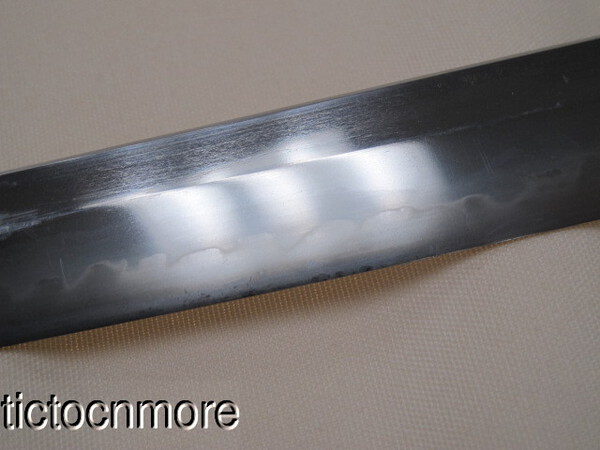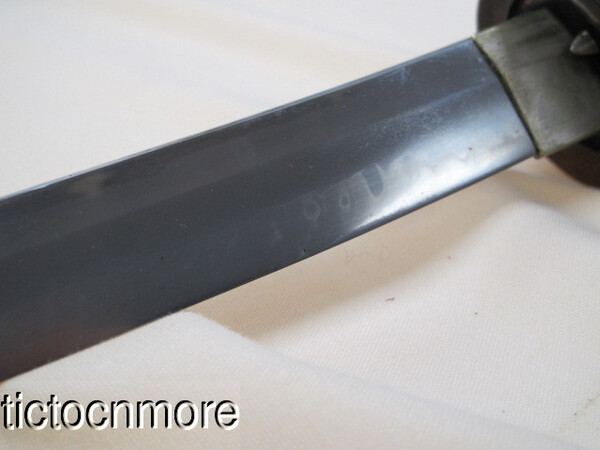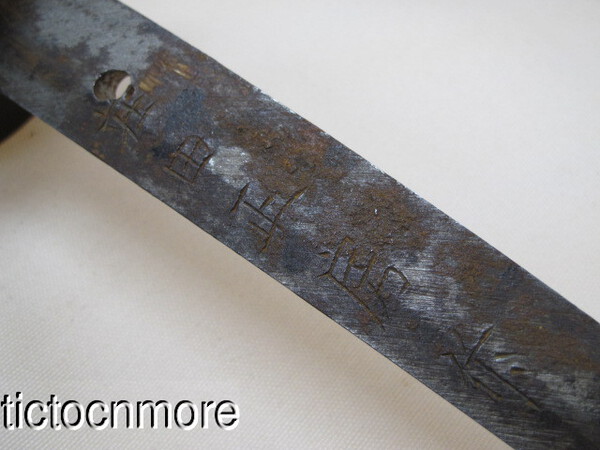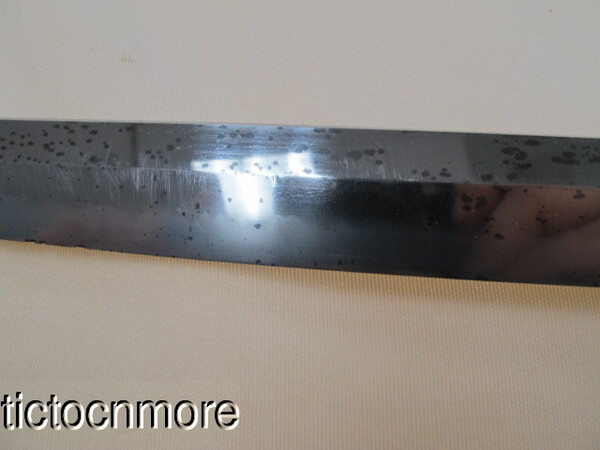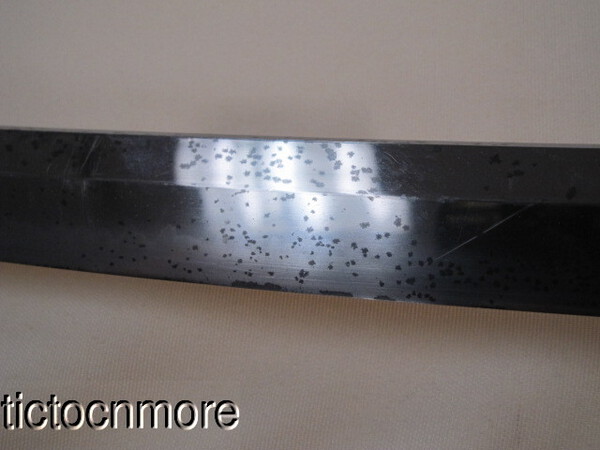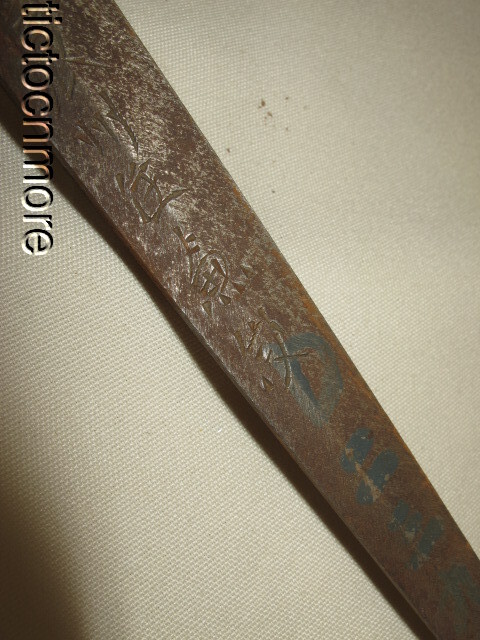
chrisf
Members-
Posts
186 -
Joined
-
Last visited
Everything posted by chrisf
-
hi guys this is showato blade or gendai ww2
chrisf replied to isidro305's topic in Military Swords of Japan
Meant to add that Kanetoshi mounted in metal saya,Masafusa in brown,rough finish lacquered wood. Thoughts anyone? Brian (bmoore) these are two of the swords that I made mention of in my response to your last Kanezane post. -
hi guys this is showato blade or gendai ww2
chrisf replied to isidro305's topic in Military Swords of Japan
Two type 3 gunto sold by ebay seller 'tictocnmore',both appeared to be gendaito,one by Kanetoshi the other by Shoda Masafusa,$1277.77 for Kanetoshi,$1025 for Masafusa which to my mind is not a lot of money but as I live in the UK am barred from bidding on them thanks to the idiocy of ebay.uk. -
hi guys this is showato blade or gendai ww2
chrisf replied to isidro305's topic in Military Swords of Japan
You may have misread that information.A blade without any stamps may be a gendaito or non-traditionally made blade,the blade in question I believe to be a gendaito. -
Must be quite a rare item and a great piece from a period of Japanese history that I find fascinating with its mix of turbulent politics,heroism and tragedy. Enjoyed visiting your site Mr Helm,excellent article on koshirae also Mito swordsmiths and 'men of high purpose',can highly recommend a visit to anyone who hasn't viewed.
-
Really like this...whilst I think I've seen something like it before,I can't remember where LOL I'm guessing maybe a formal,dress,uniform or court sword from Meiji coronation period when lots of formal tachi koshirae were produced,this one for a lesser rank and maybe worn in a frog. What is the white metal making up most of the tsuka?Silver? Looks to be more a sword to be worn and seen than used. Fascinating item,thanks for posting it.
-
MY NEW KANEZANE SWORD I PICKED UP TODAY.
chrisf replied to bmoore1322's topic in Military Swords of Japan
Brian,I'm still curious as to why you love Kanezane swords so much?30 years ago I read about Kanezane in Ron Gregory's book and had to have one,luckily I was also going to auctions at Christies South Kensington (the good old days) and it didn't take me long to realise that Kanezane blades were interesting but only as WWII items and those that I have seen and the one I owned were not even good swords but clumsy and poorly balanced. On ebay at the moment there are at least three reasonable gendaito,Sukeyuki,Shoda Masafusa and Mano Masayasu probably all at the same or less money than your Kanezane and all of them better and more interesting study pieces. With gendaito you can buy a signed researchable blade that's healthy and not been polished to death and is also of historical interest as they were real swords made to take into combat. Here's a look at one that I curently own which I hope you'll like. -
Sword construction in general vs. periods
chrisf replied to CurtisR's topic in General Nihonto Related Discussion
Have a look for Taisaburo Nakamura's notes on his wartime experiences and explanation of niku. -
Baz,a lot of Showa mei are more difficult to read than older signatures because they are not particularly well cut and are frequently done in very 'chippy' strokes. When I started to try reading mei I found it most helpful to have a pile of reference books on hand,in those days it was Fuller and Gregory's oshigata books,B.W.Robinson and eventually a Hawley,the oshigata books were of most use because it was easy to compare the oshigata with the tang in hand and eventually learn how to see the 'picture' of how the mei was made up,the Slough book is even better to use as the oshigata are bigger and clearer. Another difficulty with Showa mei is that some are done by the swordsmith (shoshinmei) and others by professional signature cutters (nakirishimei) working in the Seki gunto workshops and many of the latter have strokes that are only a token representation of the character that they are meant to be. Not easy but stick at it and the bulb will suddenly light up!
-
Most likely Sukemitsu Nobumitsu worked in Seki,real name Sukemitsu Nobukazu,licenced on 26th Oct Showa 14.Have seen a number of blades with this very 'chippy' signature,very bright steel with no evidence of hada and a misty white 'hamon' that looks etched on,lower grade gunto I guess.
-
Ichihara Nagamitsu in auction
chrisf replied to chrisf's topic in Auctions and Online Sales or Sellers
Many thanks Brian and apologies for short notice of the auction,hope somebody found it worthwhile if only for a mei reference. -
Another for gendaito fans in US,an Ichihara Nagamitsu in Garths art auctions in Delaware Ohio lot 604 tomorrow,only just had pics of mei.
-
I guess the bottom line is where do you find another? RJT swords are relatively easy to find and are still coming out of the woodwork but in several years of trawling ebay and internet sites I can recall only two other katana by Ka for sale,nearest I've got was a Shigenori I missed out on in a Scottish auction and a Horikawa Kunitake that I recently owned. Not only a rare sword but a very interesting character who made it which will account in part for the strong interest shown,much the same as with Kurihara Hikosaburo whose swords invariably are more expensive than those of more highly rated (Tokuno) gendai tosho.
-
Being sold by 'holytoledou 1',what appears to be genuine Shibata Ka gendaito,thought it might interest gendaito fans as his swords are rarely seen.
-
All well and good advice assuming that everything is original to the sword in question and that it's not been fiddled around with by some enterprising person and also assuming that the multiple contradictions can be clarified. I've always found it better to assess any sword by looking at the blade first.
-
Oshigata request: Sekimoto Yorimasa
chrisf replied to SwordGuyJoe's topic in Military Swords of Japan
Have you checked out the Chikamasa tanto on ebay?Is it the same one or are they being knocked out in bundles? -
Chris,the reference to Jean was meant to be a quote from the previous post so there was no contradiction. Like it or not,there are references to swords being broken up in the way described,can't remember exactly where,might have been Lord Redesdale or Dobree,many late 19th and early 20thC swordsmiths were unemployed as were makers of kodogu hence large numbers of trinkets,toys and curios made by highly skilled artisans. The Japanese sword is not a slashing weapon,it is a cutting weapon and its efficiency is based on the draw cut. Point vs edge has its origins in fighting with rapiers not sabres,often used with a main gauche dagger in similar style to the use of a wakizashi or o-tanto in Ni-To ryu. I too could not quite fathom the point that Kira was trying to make especially after CAB had explained all the relevant points to look for and agree with George that there was a whiff of the agent provocateur in the posts but this is a board for discussion and the question has been discussed and hopefully we have added to our knowledge.
-
I think Jean is right ---- you should collect something else, if you find nihonto so worthy of your above criticism. . WRONG!Kira is entitled to his opinion and the right to express it and is at least keeping an open mind which is more than can be said for some board members. One of the principle reasons for the continuance and longevity of the Japanese sword is the plain fact that Japan was a closed society that did not develop militarily until after the Meiji Restoration whereas in the West swords were considered obsolete and muskets,rifles and artillery ruled the battlefields. The Japanese sword has also almost disappeared from history on a number of occasions as in the late 19th century when all things Western became the fad and swords were turned into nails or used for the rims on wagon wheels and saved again twice by Kurihara Hikosaburo in the 20th century. The Japanese sword at its best is a masterpiece of forging,tempering and polishing and may be considered art.It will however still chip,bend or break and is not perfect as a weapon if you consider the swordfighting adage that the point always beats the edge.
-
I'm afraid that's a very narrow minded view as there are other weapons that have reached pinnacles of greatness,English flintlock duelling pistols,Spanish cup hilt rapiers,European wheellock pistols and tschinke,I'm sure other members can think of more. Where form and function and art conjoin nihonto do not have exclusivity.
-
Tested?Do you mean in combat?The 'Kanze' Masamune has kiri komi... In any event an individual's perception of art has NOTHING to do with rankings or expert opinions,it is precisely that:an individual perception.
-
'Beauty is in the eye of the beholder'...
-
What about WWII shingunto?If you want a 'combat' sword there are plenty of those around that have been carried and used in a war zone and while many are not traditionally made blades they may have more relevance and history than some 'antique' swords.
-
WW2 Smith - providing both Army and Navy blades?
chrisf replied to Mark S.'s topic in Military Swords of Japan
I also looked at this mainly because I had not seen this smith before and couldn't find any reference as far as gendaito smiths are concerned and wondered if this could have been shinshinto or maybe a gendai smith who worked under another name? CAB to the rescue? -
Who knows and who cares? First two swords are definitely fakes,I didn't bother to look at the rest...
-
The change in blade design post Mongol Invasion was not to improve cutting efficiency but to prevent the total loss of a sword if damaged in combat. The change to less or no fumbari and larger kissaki meant that a battle damaged sword could be repolished for continued use rather than scrapped.
-
Thank you for the explanation Morita-san and please excuse my ignorance.

